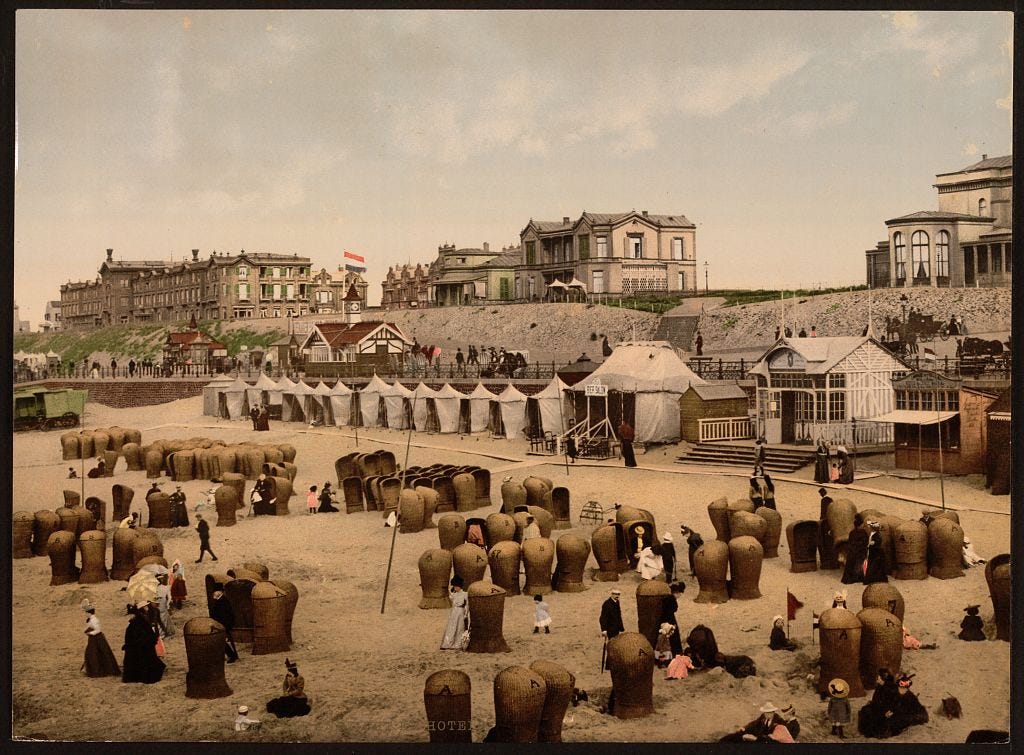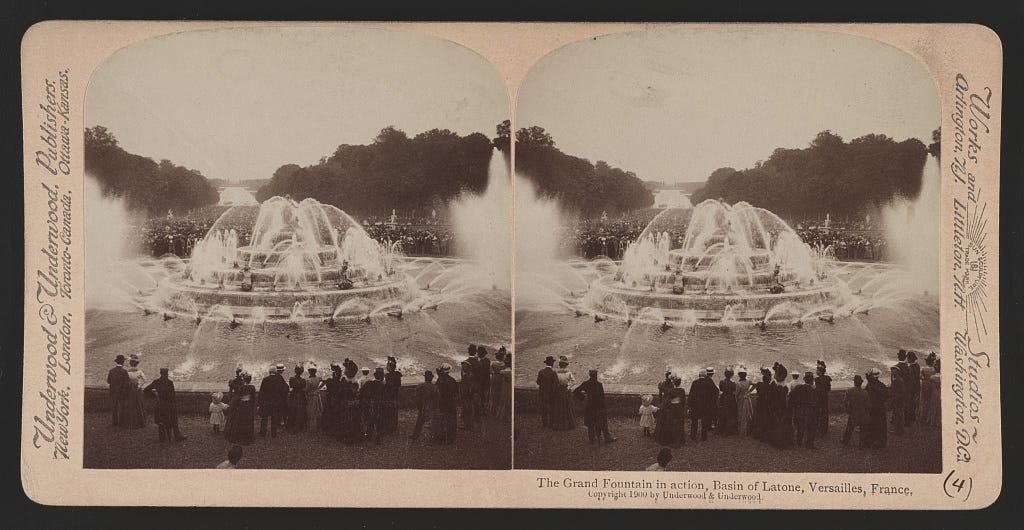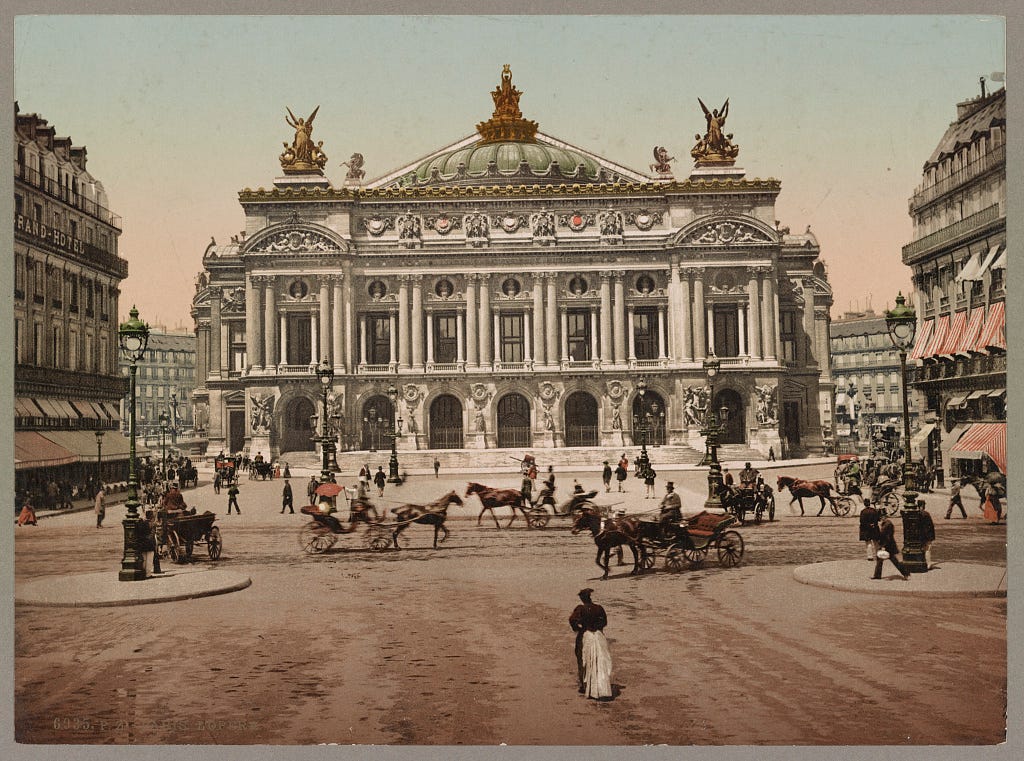Summer Saunterers Part 4
The continuing story of a trip to Europe in 1906 taken by Bessie Goldsmith and Helen and Myra Bodwell.
This week we rejoin Bessie Goldsmith and her friends Helen and Myra Bodwell on their trip. If you missed it, part 3 of this story can be found here.
We rejoin the girls as they travel from London to Amsterdam;
“At last we are on the train to Amsterdam. Such weird performance I never experienced. Though we got to Liverpool Street station a half hour before the train left we had great difficulty in getting a compartment. Such a jam I never hope to be in again. Sometime between ten and eleven we got to the boat- no porters- and our bags to be tugged an indefinite distance. Though we had paid all kinds of money for our tickets, there seemed to be some uncertainty in the frantic rush about our stateroom, but at last – to our infinite relief – we discovered an elegant little cabin on the upper deck reserved for the Bodwell party!”
On passing through customs Bessie notes, “We were called out this morning at some unearthly hour- half past four I think- and after a cup of coffee were hustled through the customs house. As I did not realize what was going to happen, the officer saw sights in my suitcase but he did not seem to mind at all.” Traveling on they arrive in Amsterdam, “Here we are in the land of canals and windmills- carrying three denominations of money and clutching the letter heading of our pension.”
On arrival at their pension, “Madame said we should fortify ourselves at once which we proceeded to do with bread, butter, jelly, cheese and good coffee, the best we have seen since we left home.” Following the hearty breakfast, the girls went shopping, “Of course the girls wanted to go shopping at once and I supervised the purchase of about fifteen dollars’ worth of jewelry.” A visit to the Ryks Museum followed.
They next travel to Marken, where, as it is Sunday, the townsfolk are dressed in national costume which Bessie describes to her mother in great detail. “I know I shall get mixed describing the different costume but here goes. The men have thick baggy cloth trousers- something like my gymnasium suit – but gored off in some mysterious fashion so that they don’t need any elastic at the knee, blouses of the same material, cravats that they tie inches below their chins and big black skull caps. They smoke pipes and wear either wooden shoes or velvet slippers- always woolen stockings. The wooden shoes are taken off when they go inside and there are little heaps at every door.” “The women had on dark skirts bound with a bright color, red or blue colored embroidered bodices laced behind & red close fitting caps.”

They travel next to Volendam by steamer. Bessie again comments on the national dress being worn. “The women wore gay colored skirts, black bodices with square necks filled in with lace and white lace caps with ears on them. I bought one but I don’t think it is big enough for me.”
A canal boat ride takes them to Edam, “We wandered in and out of the little narrow alleys between the old red-roofed houses, over planks which bridged the canals and onto a tiny sailboat which our guide had secured to take us to Edam. The owner of the boat plodded along the banks of the canal pulling us by a rope to assist the sail. His daughter sat in the stern to steer.”
Bessie considers taking back an unusual souvenir for her father who has an interest in horticulture. “Wouldn’t papa like to have me bottle up some of this green stuff on top of the canals.” It is not recorded if Bessie followed through with this.
The tour they were taking was an organized excursion, which according to the guide book preserved in Bessie’s scrapbook was newly introduced for tourists in 1904. The guide proudly states “on September 15th 1905 the tour was taken by Her Majesty the Queen-Mother of the Netherlands and the Prince and Princess of Waldeck-Pyrmont.”
After visiting The Hague, the girls visit the seaside town of Scheveningen, a famous summer resort. “The hotels are quite fine, there is a pier built out over the water and the sand is covered with these funny bath chairs.”

“Hel and I thought we would like to do something unusual, so at my instigation we went donkey riding up and down the sand- to Myra’s great horror! The beasts were very tiny and of course we rode side saddle. There was a little boy to run along behind and whack first one donkey and then the other. It was the adventure of the day.”
Traveling next to Antwerp and from there to Brussels, the girls arrive at their hotel and are dismayed to find that “… that the only bath tub was a big round one under the bed! At the mention of Public Baths our eyebrows rose somewhat, but she assured us that it was quite the proper thing. If there was anything queer to do, I wanted to do it, so Hel and I slung our clean clothes and soap into a bag and went down the street taking the first right and the first left to no. 11. Some big glass doors opened onto a little paved court on the right of which was an office and a corridor running between two rows of bathrooms. For 70 centimes I had a tub nearly full of hot water and two towels. It did seem so refreshing. I only wished I could do my hair- it is an awful mess.”
The girls travel next to Paris and Bessie describes her feelings on arrival in the city to her mother, “I think I am enthusiastic enough about Paris to suit even Papa. I’ll never forget how it looked as we rolled across the Champs Elysée with the Arc de Triumph in the distance.”
And their first priority in Paris? A visit to the hairdressers! “This morning we went to the hairdressers the first thing- you never saw anything so nasty as our heads in your life. They got all salty to begin with and have been collecting cinders ever since. He used two bottles of soap on mine- there was a fine suds- and it feels quite clean.”
A visit to the Louvre follows. “The interior of the Louvre looks just as I had anticipated but the outside is even bigger than I had thought. Papa will no doubt be relieved to know that I came upon the Venus de Milo just as advertised.” She adds,“Truly the floors are like glass. I believe they are waxed every Monday and I don’t believe it would be safe to go the first of the week.”

One of the interesting aspects of the trip is how often the girls meet people from the Boston to Liverpool steamer. Several times in her letters Bessie notes how they have met people on station platforms, while walking the streets of London, or staying in the same hotel. This is not an organized trip but many of them appear to be following the same itinerary. Paris is no exception.
“Saturday morning the Fullers called for us and we took two taximeters for Notre Dame. Three of us climbed the tower to see the big bell and the fine view over the city. From there we went to the morgue. The other girls ran out as soon as they got in, but I didn’t think it was so much worse than Madame Tussaud’s Chamber of Horrors.”
The Paris Morgue Bessie visits was built in 1864 to assist in the identification of bodies pulled from the Seine or found on the streets of Paris and was open to the public seven days a week. The bodies were displayed on tilted marble slabs in the hope that the family and friends of the deceased would identify and claim the body. However, it quickly became a popular, but gruesome, entertainment drawing up to 40,000 visitors a day and featured in many of the travel guide books. The morgue was closed in March of 1907, just after Bessie’s visit, out of concern for morality.
The next day Bessie visits Versailles.
“Sunday I had a great day. The fountains were to play at Versailles. I was wild to go -but the other girls were afraid to get in such a crowd. Miss Chapel said I might go with them so I jumped at the chance. I left Myra, Helen and Miss Andrew in bed and trotted off with my déjeuner done up in a neat brown paper by François, our valet de chamber.”
Visiting first the Petit Trianon and Grand Trianon Bessie asks her mother. “..the gardens are far beyond words and Marie Antoinette’s hamlet a dream. Why can’t I have such a house at Aldenbrook?”

“Drinks were for sale at every turn and armed with two bottles of beer we made for a huge chestnut tree beside the little lake and proceeded to have a picnic just as everyone else seemed to be doing. Picnicking seems to be much commoner here than at home and many were the groups gathered round a basket and a bottle of vin ordinaire.”
“We took a carriage to the Palais and were walking into the grounds when we espied the Bodwells and the Fullers- just that moment arrived. They couldn’t stand it any longer and had to come out to see the fountains play. Wasn’t it strange that we should meet for the place is immense and there were thousands and thousands of people there.” Bessie adds; “Never never did I see such a multitude of people streaming in every direction.”
“There was a gorgeous band concert, a merry-go-round, cake, drink, balloon and post-card vendors- nothing to remind us that it was Sunday….”
“When the fountains started to play we ran first in on direction and then in another.”
“Such a mass of people surrounded la pièce d’eau de Neptune, the last fountain to play. As soon as we had one good look we dashed for a carriage and galloped to St. Lazare where we immediately got a train for Paris. Hel says the reason we escaped the crowd was because we were Americans and knew how to hustle.”

On Monday, more shopping, “The Bon Marche was our first goal,” Bessie writes, however, she finds it disappointing. “There is nothing we haven’t quite as “smart” in America. We tried on hats with poor success.” Although Bessie did make some purchases. “Underclothes I bought this morning. I didn’t indulge in any of the ravishing 15 dollar sets such as our friends bought the other day, but got some things for every day. They are all made by hand- you will stand on end at the size of the stitches. A few chemise and night gowns can’t come amiss.”
In an effort to save money the girls visit what we would today know as a sample sale, “where the model gowns from the large shops are taken to be sold. Fabulous stories had been told of the bargains to be obtained there and I thought perhaps I could get a party coat. There were several very handsome ones, but I couldn’t bring myself to buy one that was not perfectly fresh.”
A second visit to Versailles to tour the palace itself and a visit to the Opera concludes their time in Paris.
Writing to her mother on the train from Paris to Rouen Bessie notes, “I bought a leather cover for my Baedeker.” The Baedeker is getting a lot of use on this trip. It is not only their travel guide but acts also as a flower press for the flowers Bessie collects. She goes on to describe the Opera:
“Now I don’t know whether I can do justice to the Opera or not. We certainly enjoyed ourselves but not in the conventional way. There are six seats in a box and we were told to get there early as only four of them were good. My but wasn’t the girls mad who were the last to arrive. The lights left on when the curtain rose- so I could watch the people in the house I suppose. Oh, incidentally the name of the opera was “Aida” the scene being laid in Egypt. I guess. They worked themselves up into a terrible frenzy about something & ended by being buried alive.”

The amount of shopping the girls have accumulated is becoming an issue. “I now have a big suit box besides my straw bag but I am in hopes to express it when we get to a civilized English-speaking country” and commenting on the train to Rouen, “We have a compartment to ourselves and we need it with our six pieces of baggage.”
The girls travel on to Le Havre for the boat to Southampton, where, to Bessie’s great relief, the boxes were taken to the American Express office and forwarded to Liverpool.
The girls then begin their travels through England to Liverpool where they will board the steamer back to Boston. More on that in my next, final, post.
Thanks so much for reading! We look forward to your likes, shares, comments and conversations. Your comments on the History Buzz website help build the success of the newsletter. Click here to open a free Substack account, so you can like, share, and comment.
Cheers!







